WPF CRUD Application Using DataGrid, MVVM Pattern, Entity Framework, And C#.NET

Good day to all! Here's an example of a WPF CRUD (Create,Update and Delete) project using the DataGrid control, ADO.NET Entity Framework 6.x, C#.NET and Model–View–Viewmodel(MVVM) architectural pattern. This post was based from this tutorial WPF CRUD With DataGrid, Entity Framework And C#.NET except that we are now using the MVVM framework. The steps below are pretty straightforward and easy to follow. I. Project Setup 1. Add a table called Students in you database. The complete script is found in this post WPF CRUD With DataGrid, Entity Framework And C#.NET 2. Create a WPF Project and add four folders called DataAccess, Model, View and ViewModel. 3. Your project structure may look similar with the screenshot provided below. II. Coding The Model and Repository Class 1. Inside the Model folder, add an ADO.NET Entity Data Model that connects to the Students table in your database. On my part, I named it StudentModel . 2. For the connectionstring name in App.config file, I ...


